Plate and the Planet (original) (raw)
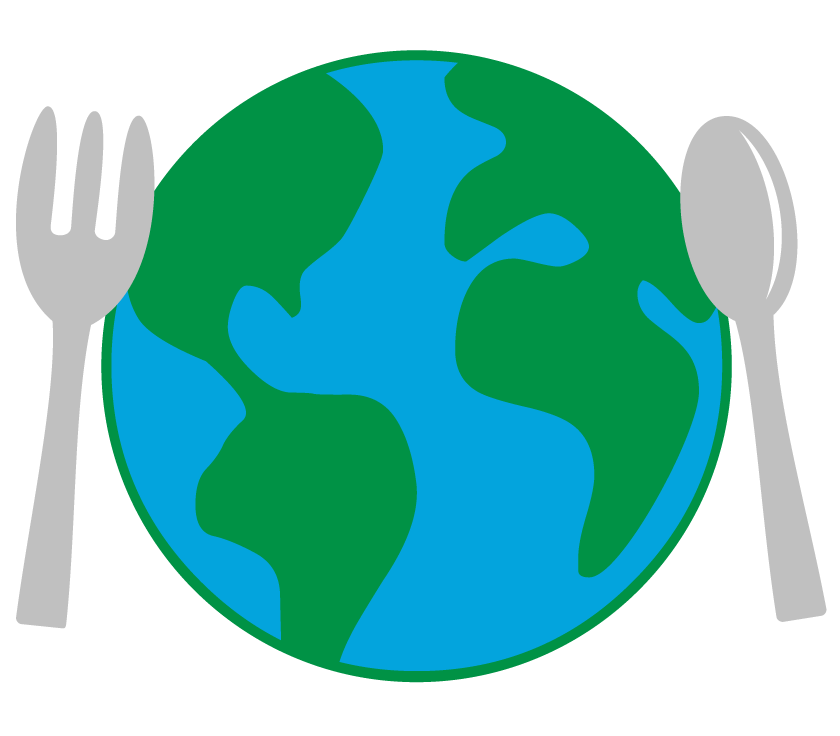
Just as different foods can have differing impacts on human health, they also have differing impacts on the environment. Shifting towards a “planetary health diet” can nurture both people and planet.
Human diets inextricably link health and environmental sustainability, and have the potential to nurture both. [1] Increased food production over the past 50 years has helped improve life expectancy and reduce hunger, infant and child mortality rates, and global poverty. However, such benefits are now being offset by shifts towards unhealthy diets.
Globally, as nations have urbanized and citizen incomes have increased, traditional diets (typically higher in quality plant-based foods), have transitioned to a “Western-style dietary pattern,” characterized by high consumption of calories, highly processed foods (refined carbohydrates, added sugars, sodium, and unhealthy fats), and high amounts of animal products. [2,3] Along with the negative human health impacts associated with this nutrition transition, this dietary pattern is also unsustainable. Current food production is already driving climate change, biodiversity loss, pollution, and drastic changes in land and water use.
Different food, different impact
Along with varying impacts on human health, different foods also have differing impacts on the environment. As shown in the figure below, the production of animal-based foods tends to have higher greenhouse gas emissions (orange bars) than producing plant-based foods—and dairy and red meat (especially beef) stand out for their disproportionate impact. Beyond emissions, it’s also important to note that food production places an enormous demand upon our natural resources, as agriculture is a major contributor to deforestation, species extinction, and freshwater depletion and contamination (in this figure, these impacts are represented by land use [green bars] and freshwater consumption [blue bars]).

(Source: World Resources Institute. [4] Details about the data used to produce this figure available here.)
Transitioning towards healthy diets from sustainable food systems—especially with our global population slated to reach 10 billion by 2050—poses an unprecedented challenge. However, research by an international working group of scientists shows this “Great Food Transformation” could be achievable through a combination of dramatic reductions in food losses and waste, major improvements in food production practices, and substantial dietary shifts toward mostly plant-based dietary patterns. [1]
Defining a “Planetary Health Diet”
In 2019, the EAT-Lancet Commission developed the world’s first scientific targets for healthy and sustainable food systems, including a “planetary health diet” with defined daily consumption ranges for each food group. This dietary pattern—characterized by a variety of high-quality plant-based foods and low amounts of animal-based foods, refined grains, added sugars, and unhealthy fats—is designed to be flexible to accommodate local and individual situations, traditions, and dietary preferences.
Scientific targets for a planetary health diet
| Food group | Intake (possible ranges), grams/day | Caloric intake, kcal/day (based on a 2,500 kcal/day diet) |
|---|---|---|
| Major carbohydrate sources – 0-60% of energy | ||
| Whole grains (such as rice, wheat, corn), dry | 232 grams (adjusted to meet energy target) | 811 kcal |
| Tubers or starchy vegetables (potatoes and cassava) | 50 (0-100) grams | 39 kcal |
| Protein – around 15% of energy intake | ||
| Beef and lamb | 7 (0-14) grams | 15 kcal |
| Pork | 7 (0-14) grams | 15 kcal |
| Chicken and other poultry | 29 (0-58) grams | 62 kcal |
| Eggs | 13 (0-25) grams | 19 kcal |
| Fish (including shellfish) | 28 (0-100) grams | 40 kcal |
| Dry beans, lentils, and peas, dry | 50 (0-100) grams | 172 kcal |
| Soy foods, dry | 25 (0-50) grams | 112 kcal |
| Peanuts | 25 (0-75) grams | 142 kcal |
| Tree nuts | 25 (0-75) grams | 149 kcal |
| Dairy foods | ||
| Whole milk or derivative equivalents (such as cheese) | 250 (0-500) grams | 153 kcal |
| Fruit and vegetables | ||
| Vegetables | 300 (200-600) grams, including: 100 grams dark green 100 grams red and orange 100 grams of other vegetables | 23 kcal 30 kcal 25 kcal |
| Fruits | 200 (100-300) grams | 126 kcal |
| Added fats | ||
| Palm oil | 6.8 (0-6.8) grams | 60 kcal |
| Unsaturated oils (olive, soybean, canola, sunflower, and peanut oil) | 40 (20-80) grams | 354 kcal |
| Dairy fats (such as butter) | 0 grams | 0 kcal |
| Lard or tallow | 5 (0-5) grams | 36 kcal |
| Added sugars | ||
| All sweeteners | 31 (0-31) grams | 120 kcal |
Created to meet nutritional requirements and promote health, all while staying within “planetary boundaries,” the Commission found that global adoption of this planetary health diet would provide major health benefits. Modeling studies show that between 10.9 to 11.6 million early deaths could be averted each year—a 19% to 23.6% reduction from current adult mortality rates. [1]
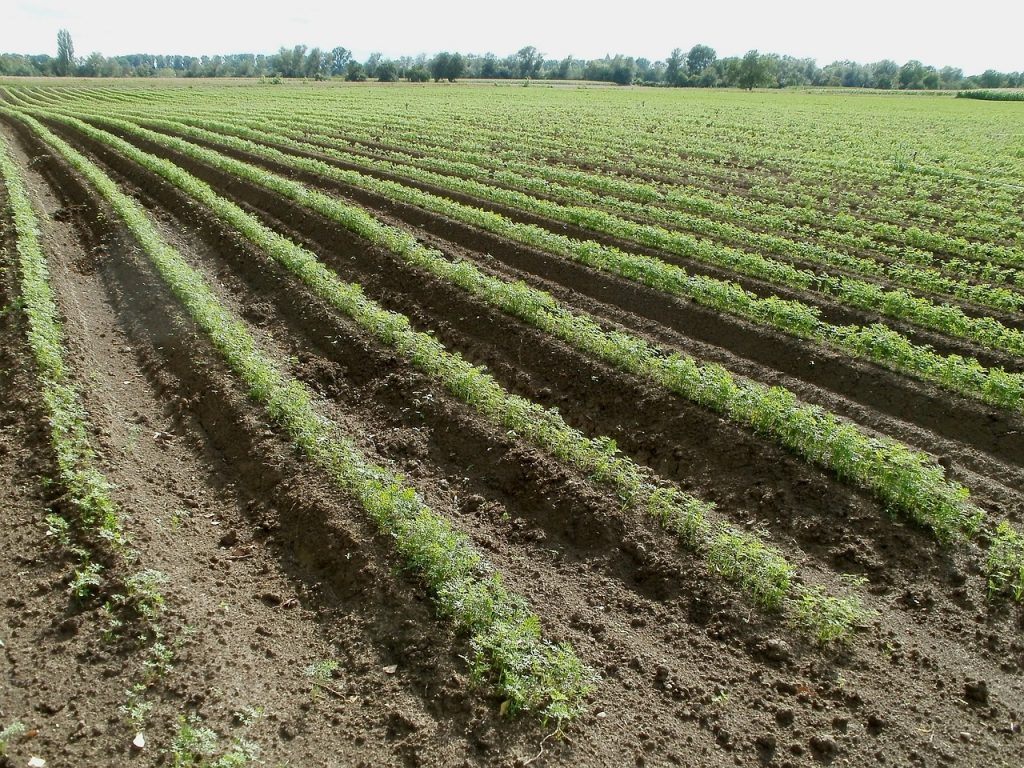
Compared with current diets, this shift will require global consumption of foods such as red meat and sugar to decrease by 50%, while consumption of fruits, nuts, vegetables, and legumes must double. That said, the Commission emphasizes the importance of tailoring these targets to local situations. For example, while North American countries currently consume almost 6.5 times the recommended amount of red meat, countries in South Asia eat only half the recommended amount. [1]
Undoubtedly, making such a radical shift to the global food system is unprecedented, and will depend on widespread, multi-sector, multi-level action. Alongside dramatic reductions in food waste and major improvements in food production practices, the Commission’s report calls for “international and national commitment” through a range of policy measures and actions needed to make healthy and sustainable foods more available, accessible, and affordable. From governments and policymakers to marketers, industry, the media, educational institutions, farmers, chefs, physicians, and consumers—everyone has an important role to play in this Great Food Transformation.
Plant-forward for planetary health
The term plant-forward is defined as “a style of cooking and eating that emphasizes and celebrates, but is not limited to, foods from plant sources—fruits and vegetables (produce), whole grains, legumes (pulses), nuts and seeds, plant oils, and herbs and spices—and reflects evidence-based principles of health and sustainability.”
Created through Menus of Change (a joint initiative of The Culinary Institute of America and the Harvard T.H. Chan School of Public Health’s Department of Nutrition), plant-forward describes a broad set of dietary patterns and approaches to menu design that deliver both personal and planetary health but also preserve a wide range of choices.
learn more about plant-forward approaches and trends
Preparing a Planetary Health Plate
It’s clear that what we put on our plates has a major impact on the environment. Eating more healthfully and more sustainably go hand-in-hand, meaning we can develop sustainable eating practices that improve our own health while also benefiting the health of the planet. If you’re interested in practicing a planetary health diet, but confused by the specific targets in the table above, here are some tips that may help:
- First of all, be sure to note that these ranges are based on daily energy intake of 2,500 calories for an average adult. That means your individual optimal intake will depend on age, body size, and level of physical activity. (The Commission’s report includes special considerations for young children, adolescents, and pregnant and breastfeeding women.)
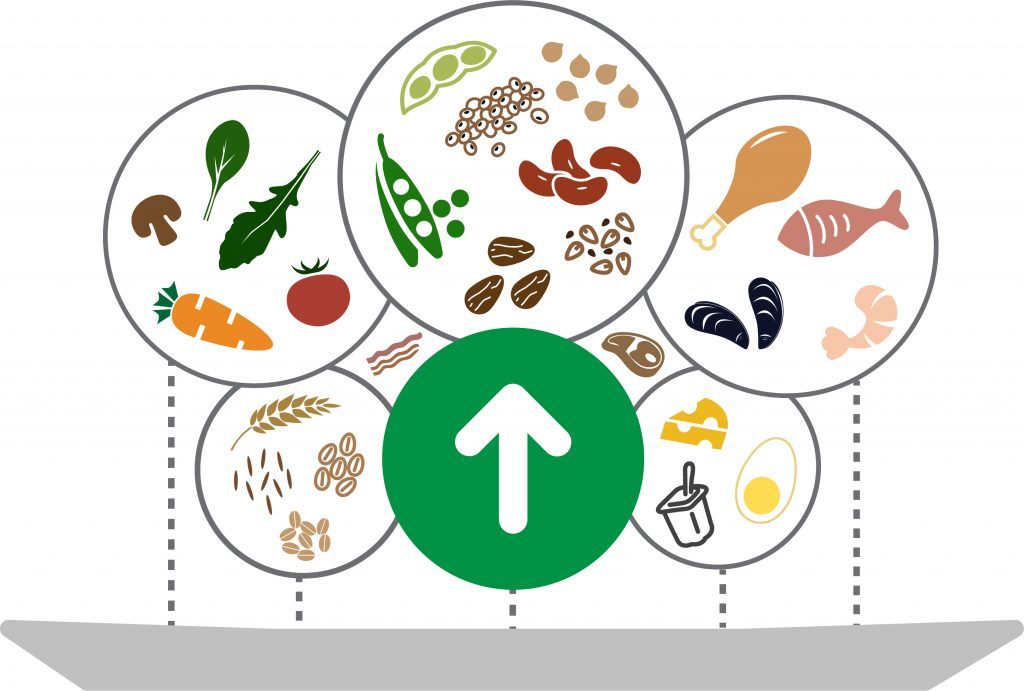 This dietary pattern is also intended to be flexible enough to accommodate individual situations, traditions, and dietary preferences. Animal products are minimized, not completely excluded, so there is a range of options for omnivores as well as those who follow vegetarian or vegan diets.
This dietary pattern is also intended to be flexible enough to accommodate individual situations, traditions, and dietary preferences. Animal products are minimized, not completely excluded, so there is a range of options for omnivores as well as those who follow vegetarian or vegan diets.- Seeing certain foods listed in grams per day may be unfamiliar. For example, how to eat only 13 grams of eggs per day when a single large egg is about 50 grams? You might be able to stick to this amount if you scramble a single egg into a stir-fry serving for multiple people, however it’s easier to think about your egg consumption on a weekly basis, where this equates to around 2 eggs.
- The same goes for other animal products. Eating even the upper-limit of 14 grams per day of red meat (a fraction of a single hamburger patty) may not be as realistic as thinking about saving this daily amount for one day during the week (e.g. eating one whole hamburger patty). Aim to consume no more than 98 grams of red meat (pork, beef or lamb), 203 grams of poultry, and 196 grams of fish per week.
- Understandably, if you’ve grown up (or have grown accustomed to) having beef, pork, and other red meats on your plate at most meals, such a change may seem daunting. But remember you don’t have to completely cut it out to make a difference for your health and the health of the planet. If you’re not quite sure where to start, here are four key approaches to cutting back the red meat while keeping your meals filling and flavorful.
- To get a sense of implementing this dietary pattern over the course of a week, here is a sample of what someone eating a varied, Western diet (of 2,500 calories) might select:
Sample 7-Day Meal Plan
Monday Breakfast: 2 slices whole grain toast spread with 1/2 of a whole avocado mashed and sprinkled with 2 teaspoons ground flaxseed, 1 cup fresh blueberries
Breakfast: 2 slices whole grain toast spread with 1/2 of a whole avocado mashed and sprinkled with 2 teaspoons ground flaxseed, 1 cup fresh blueberries
Snack: 2 tablespoons nut butter, 1 apple
Lunch: 2 cups homemade lentil soup (made 1 cup barley, kale, and 2 tablespoons olive oil), 1 orange
Snack: 1/3 cup almonds, ½ cup baby carrots
Dinner: Stuffed vegetarian bell peppers; 1 cup roasted balsamic vegetables
Tuesday
Breakfast: 1 cup plain oatmeal mixed with 1 medium diced apple, 3 tablespoons chopped walnuts, dash cinnamon
Snack: 5-ounce container Greek yogurt (look for lower sugar version)
Lunch: Sandwich on 1 medium whole grain pita or wrap with 3 ounces leftover rotisserie sliced chicken, 1/2 sliced avocado, sliced tomatoes, 1 cup baby spinach; 1 fresh pear; 1 ounce bag plain popcorn
Snack: 1 large banana, 2 tablespoons peanut butter
Dinner: fish tacos with cilantro slaw
Wednesday
Breakfast: 1 cup unsweetened shredded wheat cereal, 1/4 cup raisins, 3 tablespoons chopped pecans, 1 cup dairy or soy milk
Snack: 1 cup strawberries, 1 string cheese
Lunch: Takeout meal – house garden salad with crispy tofu, 2 tablespoons olive-oil based dressing, 1 small whole grain pita bread
Snack: 1/3 cup walnuts, 1/3 cup pitted dates
Dinner: 3 ounces baked salmon, 1 cup quinoa mixed with 1/2 cup black beans, 1 1/2 cups steamed kale and carrots drizzled with 2 tablespoons olive oil-based salad dressing
Thursday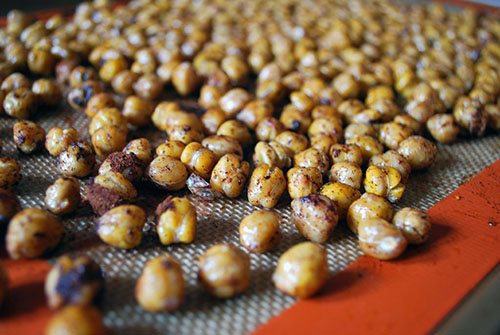 Breakfast: 1 cup plain yogurt mixed with 1 tablespoon honey or maple syrup, 2 tablespoons chia seeds, and 1 diced kiwi
Breakfast: 1 cup plain yogurt mixed with 1 tablespoon honey or maple syrup, 2 tablespoons chia seeds, and 1 diced kiwi
Snack: 1 ounce dark chocolate with nuts
Lunch: Sandwich of canned drained tuna mixed with 1 tablespoon mayonnaise, diced celery, squeeze lemon juice, dash black pepper; 2 slices whole grain bread; 1 fresh orange
Snack: 1 cup crunchy roasted chickpeas
Dinner: 4 ounces roasted chicken, 1 medium skin-on baked potato (white or sweet) drizzled with 1 tablespoon olive oil and 1 tablespoon Parmesan cheese, 2 cups salad (leafy salad greens, chopped cucumbers, 1 small diced tomato), salad dressing (2 tablespoons olive oil, 1 tablespoon balsamic vinegar, dash garlic powder)
Friday
Breakfast: Roll-up made with flaxseed wrap spread with 2 tablespoons nut butter and 1 medium sliced banana
Snack: 1 hardboiled egg, 1 cup grapes
Lunch: Garden salad with seitan and snap peas, carrot and coriander soup
Snack: 6 whole grain crackers, 3 tablespoons white bean and kale hummus
Dinner: 2 slices cheese pizza on whole grain crust with additional diced tomatoes, mushrooms, broccoli; side green salad
Saturday
 Breakfast: 1 egg scrambled, 1 whole grain pancake topped with 1 tablespoon maple syrup or honey and 2 tablespoons chopped almonds, 1 cup blueberries
Breakfast: 1 egg scrambled, 1 whole grain pancake topped with 1 tablespoon maple syrup or honey and 2 tablespoons chopped almonds, 1 cup blueberries
Snack: 1 red bell pepper sliced into strips, 2 tablespoons hummus
Lunch: Butternut squash soup, 6 whole grain crackers, 2 clementines
Snack: 1/3 cup peanuts, 1/4 cup dried apricots
Dinner: Stir-fry made with 2 ounces sliced broiled sirloin steak, 1 cup broccoli florets, 1/2 cup diced bell pepper, 2 crushed garlic cloves, 1 cup brown rice, 1 tablespoon reduced-sodium soy sauce, 2 tablespoons canola oil
Sunday
Breakfast: 2 small homemade blueberry muffins, 5 oz. low sugar Greek yogurt mixed with 2 tablespoons ground flaxseeds, 1/2 cup strawberries
Snack: 1/3 cup cashews
Lunch: Minestrone soup (made with bulgur, 2 tablespoons olive oil), 1 cup cantaloupe
Snack: 1 ounce of tortilla chips, 1/2 cup salsa
Dinner: 5 ounces baked tilapia seasoned with lemon juice and black pepper, 1 cup quinoa mixed with 1 tablespoon sunflower seeds, 2 cups Caesar salad
- It also helps to see these targets visualized as a complete plate—half of which would be filled with fruits and vegetables (starchy vegetables, like potatoes, are limited), while the other half should consist of primarily whole grains and plant-based protein foods, with unsaturated oils and modest amounts of animal-based protein foods. Look familiar? This guidance is closely aligned with the Healthy Eating Plate.
What Else Can I Do?
Alongside a shift to a planetary health diet, moving towards a more sustainable food future will also require major improvements in food production practices and significant reductions in food losses and waste. Food waste is another complex problem that occurs well before our homes, but here are some strategies for shopping, storing, and repurposing that can minimize your personal impact.
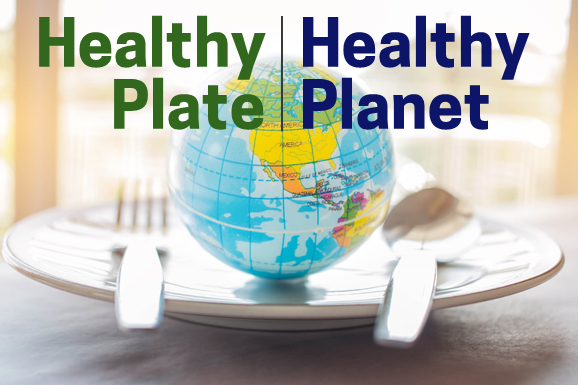
LEARN: Simple steps to optimize personal and planetary health
In just 10 minutes, this interactive learning program shows how key food choices can impact your health—and that of the planet. Learn why certain foods deserve special attention and discover a flexible approach that can work for everyone. This free interactive learning experience is a fun and practical educational tool for all ages. A collaboration between the educational nonprofit Gaples Institute and the Department of Nutrition at Harvard T.H. Chan School of Public Health.
Learn more about sustainable diets
Related
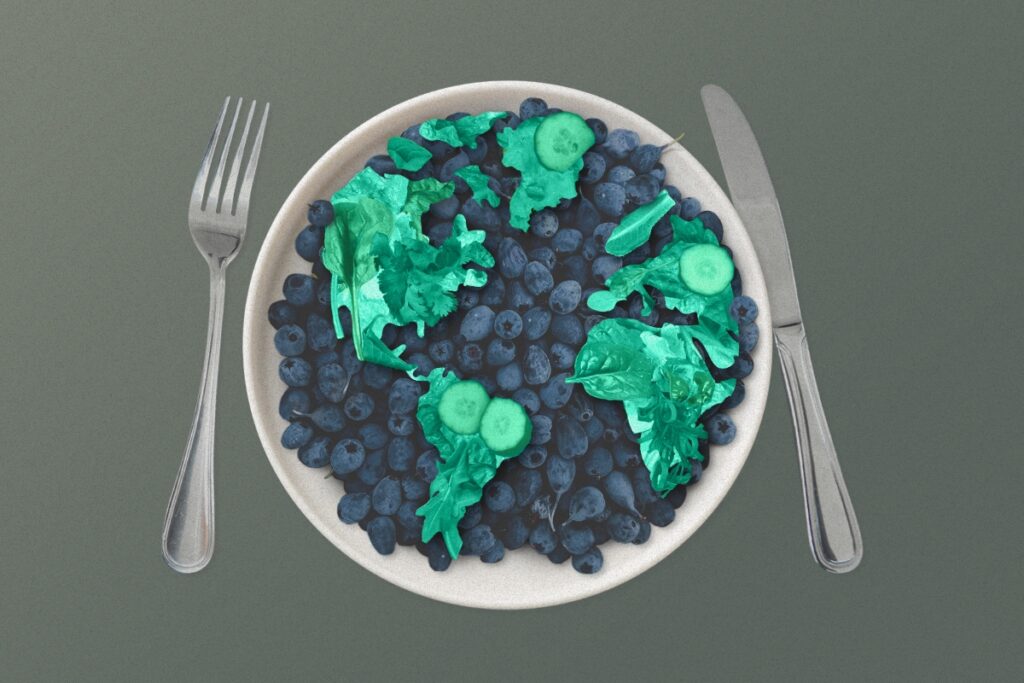
WATCH: Eating for a healthy body and a healthy planet
Our diets clearly affect our health — and they may also determine the future of our planet. This recorded panel discussion from the Harvard Chan Studio examines the connections between personal and planetary health, with a particular emphasis on how our dietary choices can influence climate change, antibiotic resistance, and food security. Panelists explore concepts including mindful eating, cultivated meat, “blue” diets rooted in the ocean, and sustainable agricultural practices.
References
- Willett W, Rockström J, Loken B, Springmann M, Lang T, Vermeulen S, et al. Food in the Anthropocene: the EAT–Lancet Commission on healthy diets from sustainable food systems. The Lancet. 2019 Jan 16.
- Popkin BM, Adair LS, Ng SW. Global nutrition transition and the pandemic of obesity in developing countries. Nutrition reviews. 2012 Jan;70(1):3-21.
- Delgado CL. Rising consumption of meat and milk in developing countries has created a new food revolution. The Journal of nutrition. 2003 Nov 1;133(11):3907S-10S.
- Ranganathan J, Vennard D, Waite RI, Dumas P, Lipinski B, Searchinger T. Shifting diets for a sustainable food future. World Resources Institute. 2016 Jun.
- EAT. Summary Report of the EAT-Lancet Commission. 2019.
Terms of Use
The contents of this website are for educational purposes and are not intended to offer personal medical advice. You should seek the advice of your physician or other qualified health provider with any questions you may have regarding a medical condition. Never disregard professional medical advice or delay in seeking it because of something you have read on this website. The Nutrition Source does not recommend or endorse any products.